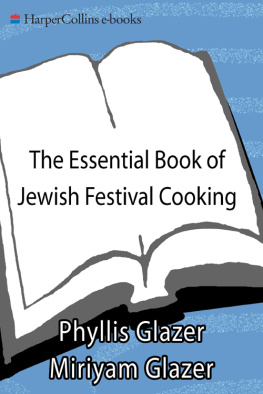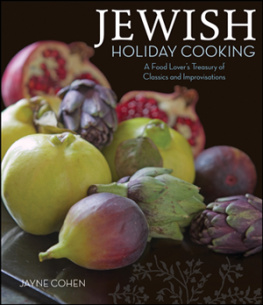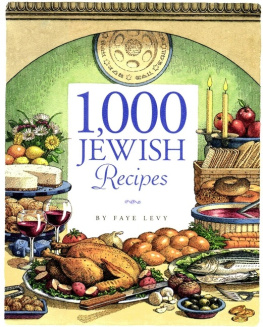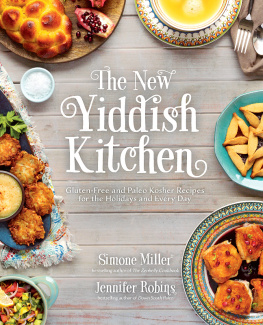ACKNOWLEDGMENTS

Writing a cookbook always involves the help of many people. I would like to thank the following friends and family for expert advice, ideas, and recipes: Susan Barocas, Beverly I. Colman, Mickey Feinberg, Paula Gerson, Ellen Gold, Mary Lynn Goldstein, Anne Kampelman, Reba Leand, the late Rabbi Eugene Lipman, Charlotte Muchnick, Ellen Neschis, Dorothy Regen-steiner, Cantor Arnold Saltzman, Marian Sofaer, Mark Talisman, Elizabeth Wallace, and Barbara Winnik. I would also like to thank Adas Israels Gan Ha-Yeled and Jewish Primary Day School for introducing my children to so many Jewish customs.
BOOKS BY JOAN NATHAN
The Foods of Israel Today Jewish Cooking in America The Jewish Holiday Baker The Jewish Holiday Kitchen The Children s Jewish Holiday Kitchen An American Folklife Cookbook The Flavor of Jerusalem (with Judy Stacey Goldman)
SABBATH
WINTER FRIDAY NIGHT MENU Strips of Green Peppers, Cucumbers, and Carrots Fruit Kugel Danielas Brownies
SUMMER FRIDAY NIGHT MENU Tree of Life Salad with Hummus Mixed Berries
WINTER SATURDAY LUNCH MENU Hallah Jaffa Orange Sorbet
SUMMER SATURDAY LUNCH MENU Hallah Cucumber-Yoghurt Salad
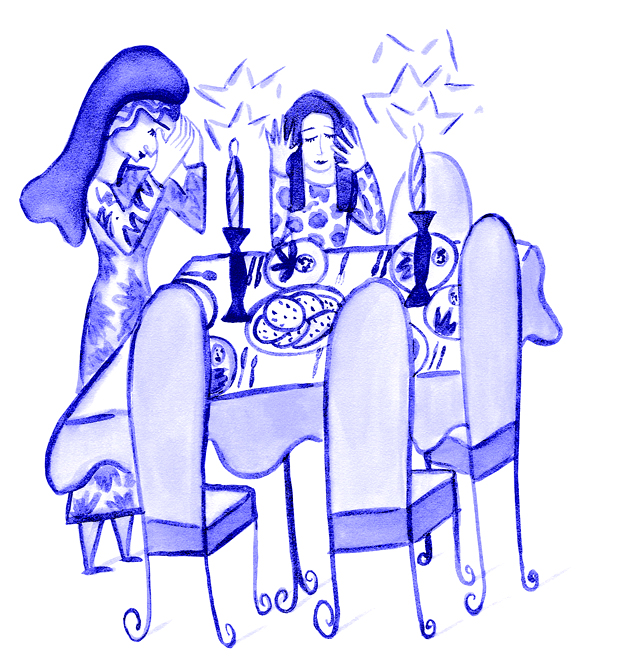
SABBATH

In America today, the way each family spends the Sabbath is highly personal. In our family, we desperately need to slow down and spend time together.
When our children were younger, sitting still in the synagogue was difficult for them. Whereas my husband, Allan, would occasionally take the older children, I found it extremely difficult with an infant, so I preferred taking long walks as a family or hanging around the house. Now we are at the Bar and Bat Mitzvah stage and find special meaning in going to synagogue as a family. Our favorite time of the week is Friday night, when everything relaxes. I always remember when I lived in Jerusalem and there was that frantic rush to prepare for the Sabbath. Mothers breathed a sigh of relief when all the preparations were completed, because they could relax.
Now we rarely go out on Friday night and often invite other families to dine with us. When the children were small, they drew a decorated menu before each Sabbath, with stars to show which dishes they had cooked themselves (this also alerted adults to the tenor of the meal and let them know that extravagant compliments would not be out of place!). We set a pretty table, more often than not with a white tablecloth, fresh flowers, white candles, our best china, and a hallah which we bake together. The hallah is placed on a silver platter my father brought to this country when he emigrated from Germany. The hallah cover alternates between one made by Merissa in school and one stitched by a grandmother. Everybody has his own kiddush cup, some filled with white or red wine, others with apple or grape juice.
Standing at the table, Daniela, Merissa, and I cover our eyes. Then, together we say the blessings over the candles: Baruch atah Adonai Eloheinu melech ha-olam, asher kidshanu bmitzvotav ve-tzivanu lhadlik ner shel Shabbat.Blessed art Thou, O Lord our God, King of the universe, who hast sanctified us by Thy commandments, and commanded us to kindle the Sabbath lights. Allan says the blessings over the wine and the bread in our family, but in many of our friends families everyone says the blessings together: Baruch atah Adonai Eloheinu melech ha-olam, borei pri ha-gafen. Blessed art Thou, O Lord our God, King of the universe, who createst the fruit of the vine. We all sip the wine. Then Allan says the blessing over the hallah: Baruch atah Adonai Eloheinu melech ha-olam, ha-motzi lechem min ha-aretz.Blessed art Thou, O Lord our God, King of the universe, who bringest forth bread from the earth. Then one of the children breaks off pieces of bread to pass to everyone who is at the table. They find it more fun to rip apart the hallah on Friday night than to cut it with a knife. For some people, this custom is also symbolic of the special peacefulness of the Sabbath.
Then Allan spreads his hands over the heads of the girls and blesses them: Ysimech Elohim kSarah, Rivka, Rahel vLeah.May God bless you like Sarah, Rebecca, Rachel, and Leah. For our son, David, he says, Ysimecha Elohim kEphraim vhi-Menasheh.May God bless you like Ephraim and Menasheh. Then we kiss each of our children and say, Shabbat shalom. Allan sometimes tells a story from the weeks Torah portion, gearing his short talk to the age of our children, sometimes linking what he has to say to the news of the week. Often he will test them by asking questions from the week before. The Jerusalem Post and the local Jewish newspaper include commentaries on the portion of the week. Good books to buy are Nehama Leibowitzs six-book series Studies in the Torah (Jerusalem, 1980) and The Way of the Torah by David Epstein (New York, 1986). Occasionally we sing Hebrew and Yiddish songs. Hallah board: Use any old board that seems the shape you would like for a hallah board. Hallah board: Use any old board that seems the shape you would like for a hallah board.
Sand the wood. Let the children paint it or even make handprints in finger paint and shellac it. Hallah cover: Use a piece of cotton or other nonwater-repellent fabric. Place water in jars with vegetable skins for color: grapes for purple, onion skins for brown, beets for red, parsley for green. Zap them in the microwave or boil until you get the color you wish. The children can then use a paintbrush or medicine droppers to color the cover.
This is an especially nice task at Rosh Hashanah or Sukkot, with the different fruits and vegetables of the harvest used as the paints. Rinse the cover in vinegar, which will set the color. Shabbat place mats: Let the children paint or color cardboard or durable construction paper. Then cover with clear contact paper or even plastic wrap. Tape the place mat down. Kiddush cups: Have the children decorate plastic cups with permanent marking pens and write the name of each family member and guest on them.
They can then be used as place cards as well. Candlestick holders: Have the children make the holders out of homemade clay. Mix together 4 cups flour, 1 cup salt, and about 1 cups water to make a stiff dough. Divide the dough into balls the size of Ping-Pong balls. The children can mold them as they wish.
GRAPE JUICE

In India, the eldest daughters role is to make grape juice fresh each Thursday for the Sabbath meal.
GRAPE JUICE

In India, the eldest daughters role is to make grape juice fresh each Thursday for the Sabbath meal.



